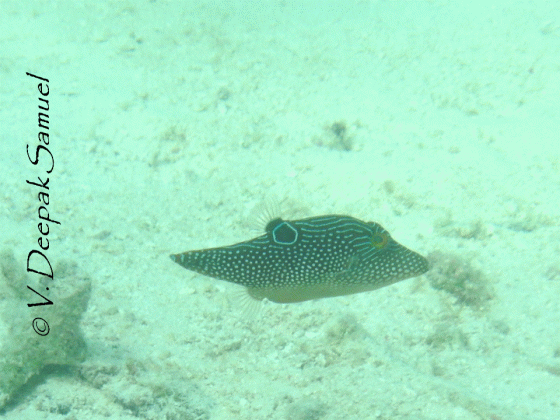
The Spotted Sharp Nose Puffer Canthigaster solandri – caught in camera at 3.2 meters depth @ Kavaratti, Lakshadweep Islands
The first time I saw a puffer fish was in my eighth grade on a visit to the Marina Beach at Chennai (Madras). I was taken by surprise because I was attempting to kick a ball lying on the beach that slowly started to deflate. A mysterious, funny looking fish started to wriggle about in search of water. Later I came to know through an uncle of mine that it was a puffer fish. Years later, I had the opportunity to shoot a live spotted sharp nose puffer Canthigaster solandri in its habitat while SCUBA diving in Kavaratti, Laksadweep Islands.
Puffer fishes are also known as blowfish or toadfish and come in diverse forms and colours. Literature points out that puffer fishes are the second most poisonous living things on earth after the Golden Poison frog. Poison is found either in the internal organs or in the skin below the epidermis.
The specialty of puffers is their amazing capacity to expand their body and transform it into a rounded, ball – like composition, scaring away their predators. Some species have spines over their body that project out when the body inflates (swells up), and has the ability to puncture the predator’s body.
For the spotted sharp nose puffer, the skin is poisonous. They are also called as false eye toby or nettled puffer because of the black dorsal spine spot and the white lines running horizontally from the eye a little distance in the dorsal side of the body. An easy external identification character for spotted sharp nose puffer is the prominent dark spot on the dorsal fin giving a pseudo eye effect. They are reef associated, medium sized species inhabiting the tropical coastal waters. Members of this genus grow less than 12 cms and have a characteristic relatively long, pointed snouts (hence the common name) with vibrant colors all over their body.
Canthigaster solandri mainly feeds on filamentous red and green algae, sometimes on corals, tunicates, mollusks, echinoderms, polychaete worms, crustaceans and bryozoans. The juveniles are often found close to branching coral colonies for protection against predators.
Some species of puffer fish meat is eaten in Japan, Korea and China and is considered to be a seafood delicacy. It is often termed as “death meal” by some because if cooking the fish goes wrong, it might lead to death. There are more than 120 species of puffer fishes recorded in the world oceans. With their bulging eyes, puffing up body, ornamentation with spines or vibrant colors on their body, puffers are a real treat to the eye.
Taxonomic position
Phylum: Chordata
Class: Actinopterygii
Order: Tetradontiformes
Family: Tetradontidae
Genus: Canthigaster
Species: C. solandri
This is copyrighted material © Deepak Samuel

Astonishing , Inqusitive information sir , n pulicat i hav seen puffer fishes of 2 families such as tetradontidae , diodontidae ..;).especially.ur blog s very useful for me for preparing seminar & presentation …..
Thanks Umer… keep reading!
Good work deepak.
Thanks Tilak.. keep reading
@Deepak : welcome sir .
love your blog; great going deepak! keep it up. God bless. SS/MCC
Hi Godfather! gud to c u commenting on my blog! thanks for the compliments! Do keep reading and Hi to all there!!
Hi you have a fantastic website over here! Thanks for sharing this interesting information for us! If you keep up the good work I’ll visit your weblog again. Thanks!
Do keep reading as many more interesting facts on the Indian marine life is on it’s way!
Interesting info anna…for the first time in reading your blogs, I am glad to say I actually saw first-hand, the creature you are talking about…. 🙂 Spavin, Aarthi and I came across a dead puffer fish while taking a walk on the beach at the SU campsite once 🙂
Thats good Sheens! do you have a pic of the one u guys saw?? I can identify and tell you what species it is! Wasn’t it amazing when you saw the puffer? for first timers “Curiosity kills the cat” tag works well! Keep reading Sheens!
I think we did take a picture of it anna….will try to fish it out and mail it to you…you are so right…I am usually pretty cautious, but spavin wanted to carry it…but we had heard that their pins are poisonous, so i don’t think we tried carrying it….i am not sure though….its amazing that it had died in a puffed-up state, and had stayed almost in that state…does that happen? how does the shape remain when it is dead?
Dear Sheens, when the fishes die they undergo a process called RIGORMORTIS – a biological process post death that allows the fish to become hard and dry in the same state! when puffers puff up and die, their swimbladders are filled with gas and remains as such for some time.The one u guys have seen would have been dead for a couple of hours! once time clicks on, decomposition sets in by action of bacteria that starts converting organic matter into inorganic matter. This will allow the swim bladder and the animal’s viscera to burst open…hope this clarifies.. read on RIGORMORTIS from some trusted site to understand more… KEEP READING SHEENS!
I have read about rigor mortis in some murder mysteries anna…but somehow I had the feeling that what was inside the puffer fish was air, and so it would come out once the fish died…I guess I thought the fish was willfully holding the air like we would hold an air bubble in our mouths 🙂 how silly I must sound to all your zoology friends 🙂
To be very frank Sheens, many zoologists do not know this either!
🙂 That definitely makes me feel much better:)
Ha ha…
really gud one sir
thanks Margi.. keep reading.. there is one more blog coming today…